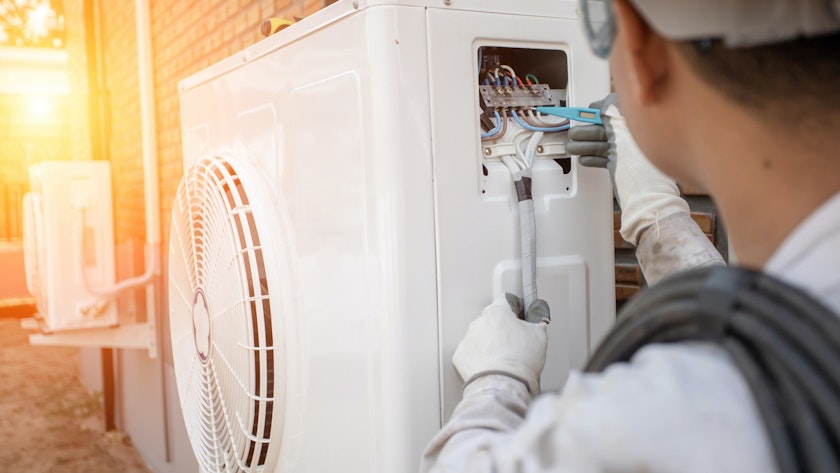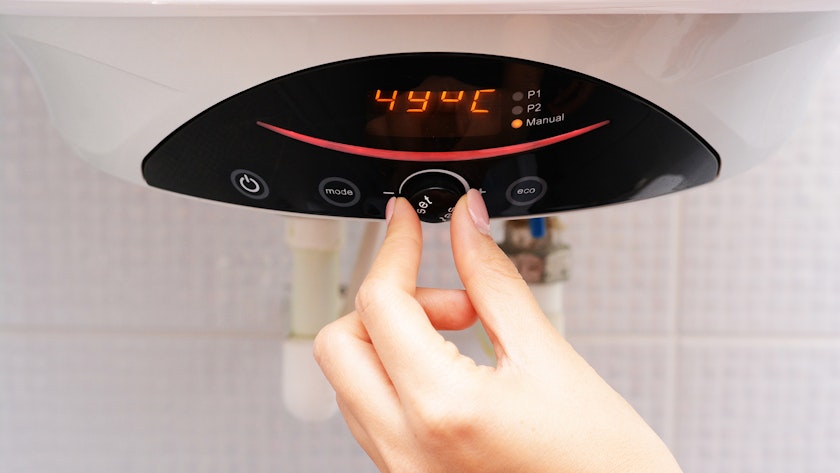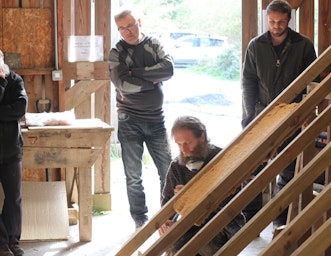
CAT’s Zero Carbon Britain scenario mainly uses heat pumps for heating, but it’s not the only option being championed for a zero carbon future. Joel Rawson looks at the potential of some other technologies in the frame.
Originally published in our member’s magazine Clean Slate 121 – Autumn 2021
One of the biggest challenges we face in a zero carbon transition is moving away from the fossil fuels that most homes still rely on for heating.
In our Zero Carbon Britain report, heat pumps replace gas or oil boilers or electric heating in most homes, plus a sliver of biomass heating for some rural areas. But other options are being promoted, including hydrogen, heat networks and direct electric heating of various kinds. Can these offer the same level of carbon saving? And what are the implications for infrastructure to support them?
Heat pumps
You can read much more about using this technology on our heat pumps information page. The key thing to keep in mind when comparing the options below is that a well-specified heat pump should give three or four units of heat for every unit of electricity consumed. Due to their low electricity use, the overall carbon emissions from a heat pump will already be about one-third to one-sixth as much as those from a gas boiler (and will continue to decrease).

There’s a useful case study on the website of Trystan Lea, one of the researchers for the energy modelling in CAT’s latest Zero Carbon Britain report.
Monitoring of Trystan’s own home heat pump system shows how with the right choice of radiators the annual electricity-to-heat ratio is 3.9. And that’s without high levels of insulation. In 2020, through a careful choice of variable tariff they bought electricity for an average rate of about 11p per unit (kWh), which was about two-thirds the usual rate at the time. That meant the effective heating cost was less than 3p per unit, which was about two-thirds as much as they would have paid to heat with gas. However, perhaps the most important thing is that the carbon emissions were about 80% less than they’d be on gas.
You can read more at https://trystanlea.org.uk/heatpump2020
Please note that those prices were before the current spike in wholesale energy prices in late 2021, which is causing higher prices for both gas and electricity. However, as both are rising the comparions between the two should remain similar or could be more in favour of a heat pump.
One key barrier to putting in a heat pump is the higher upfront cost, but this should drop with investment and mainstream adoption, as happened with solar PV and wind farms. At the moment, support is available through the Renewable Heat Incentive (RHI), but this will be replaced with a grant scheme in April 2022. The proposed ‘Clean Heat Grant’ is now being called the ‘Boiler Upgrade Scheme‘. The grant is due to be £6,000 for ground source heat pumps and £5,000 for air source heat pumps or biomass boilers (with biomass heating only covered in a few special cases of ‘hard-to-heat’ homes).
Are there other zero carbon options?
Various different heating systems come up in questions to the information service and in the media, and here I run through some of the key points to bear in mind. I’ll be adding more detail to the information service pages to help people make balanced choices. I’d also like to hear if you’ve had either good or bad experiences with any of these.
Any system can be mis-sold, and a potentially good option could be sized incorrectly, or have the wrong choice of controls, or be overpriced. Salespeople may make over-optimistic claims about carbon savings or running costs, and perhaps even disingenuous comparisons with other systems.
Of course, insulation and related measures are the most important investment – whatever the heat source. We must reduce heat demand nationwide, so that’s its feasible to move as quickly as possible to only zero carbon energy sources.
To complement funding for heat pumps, we will need ways of supporting people to reduce their home-heating requirements. To date we haven’t heard if there will be a full replacement for the withdrawn Green Homes Grant, which would have helped people make energy improvements, but was stymied by administrative problems. There is some support through the Local Authority Delivery scheme if you have a lower household income and live in a house with a low EPC rating.
See CAT’s information service web pages for more on insulation and retrofit planning and funding.
Heat networks
A heat network, or district heating, takes heat produced at a central point and pipes it around many buildings. Clearly this isn’t something you can just choose, as it depends on planning across a number of homes. It can be a great solution, especially for denser housing. However, the carbon intensity of heat networks will vary, depending on where the heat comes from. It could be a by-product of industrial processes, from a shared heat pump, from true geothermal energy, from anaerobic digestion of agricultural and domestic green waste, or incineration of municipal mixed waste.
The potential for a heat network could be identified and developed as part of a zero carbon action plan for a region or town. If you think it could work for you and your neighbours, you could spur action by getting involved in local zero carbon action planning. CAT’s Zero Carbon Hub and Innovation Lab is working to support communities and councils with resources and training.
Hydrogen
There’s currently a fair amount of promotion of ‘hydrogen-ready’ boilers, which seems to be led by the fossil fuel industry. At the moment only ‘grey hydrogen’ is produced, from the steam reformation of natural gas. So it’s still a fossil fuel and leads to higher carbon emissions than gas. The main industry proposal is for ‘blue hydrogen’, made by the same process but adding in a not yet invented way of capturing and storing the emitted carbon. There are questions about how this will be achieved.
‘Green hydrogen’ is made from the electrolysis of water using electricity from renewable sources. The Zero Carbon Britain model allocated excess electricity to make green hydrogen and other synthetic fuels. These are important for purposes such as manufacturing, fuelling larger vehicles and planes, and running ‘peaker plants’ at times of high grid demand.
Using hydrogen to heat homes raises questions given how valuable it is for those other uses and the difficulty of making it. A heat pump can use 1 unit of electricity to give 3 or 4 units of heat. Whereas via hydrogen, 1 unit of electricity might give only 0.6 units of heat (if hydrogen generation is 70% efficient and the boiler 90% efficient).
Overall, the heat pump would then be 5 or 6 times as efficient as hydrogen at delivering heat from renewable electricity. In theory it could all be zero carbon, but if hydrogen is more than an occasional top up option it will demand far more electricity generation (and so several times as many wind and solar farms).
CAT’s Zero Carbon Britain model avoided ‘silver bullets’ – including technologies not yet developed and with uncertain timescales. The current proposals for hydrogen do have a silvery look. We know that heat pumps will work and will reduce carbon emissions, but a ‘hydrogen-ready’ boiler might never actually reduce carbon emissions.
Direct electric
In theory, direct electric heating (such as an electric boiler, radiator or underfloor heating) has the potential to be ‘zero carbon’, and a careful choice of tariff can reduce the running costs a bit.
However these can’t be more than 100% efficient, and therefore consume 3 or 4 times as much electricity as a heat pump for the same heat demand. As well as much higher running costs, there’s the issue again of the infrastructure needed to generate all that electricity.
We therefore treat with caution any claims for these sorts of electric heating as an energy saving measure. A little electric heating might be part of a heat pump system, to top up in the coldest weather, but we really want to minimise the use of direct electric heating.

Infrared
The direct electric options mentioned above deliver heat in the same way as water based radiators or underfloor heating. The claim for ‘far infrared’ heating is that because it heats people and surfaces rather than the air, the electricity use will be much less while delivering the same thermal comfort.
However, at the moment it’s hard to find a detailed breakdown of performance – it’s something we’re continuing to pursue. Comparisons need to be evaluated carefully, for example they might be with a heat pump that has a lower electricity-to-heat ratio than should be achievable with proper design.
Anecdotally, some have found that far infrared works well in a bathroom, but they’ve preferred warm air heating elsewhere. But this doesn’t mean it couldn’t work in some circumstances, and we need better data to make fair comparisons.
About the author
Joel Rawson is CAT’s Information Officer, providing free and impartial advice on a wide range of topics related to sustainability. He first came to CAT to volunteer in 2001, and graduated with a CAT Postgraduate Diploma in 2013.
- Zero Carbon Britain
- Climate Change
Related Topics
Related Pages
Related news


CAT Conversations: Sandy Stevens, CAT graduate
17th April 2025
CAT stories – Nick Parsons and Mike Russell
29th January 2025
‘The finance COP’
29th November 2024Email sign up
Keep up to date with all the latest activities, events and online resources by signing up to our emails and following us on social media. And if you'd like to get involved and support our work, we'd love to welcome you as a CAT member.
